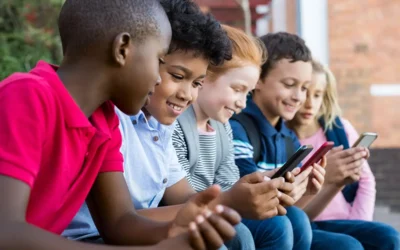We live in a world saturated with photography. We are so used to photographing and being photographed we’ve grown blind to the value of our own image. Images – our likenesses – are personal information. The viewing, use, downloading, copying or sale of our likenesses by someone other than ourselves should always be a point of concern – or, at the very least, a point of interest that gives us pause and encourages us to think in terms of consequence, especially for our children. How do we better protect our images shared online?
In Australia 1 in 3 young people have reported at least one form of image-based abuse or victimisation. The RMIT study also says 80 percent of victims experiencing threats to distribute an image reported prominent levels of psychological distress, consistent with a diagnosis of moderate to severe depression and/or anxiety disorder. In terms of consequence, this places the seemingly benign social sharing of images online in a new light.
“Online bullies’ weapon of choice was image-based attacks, like photo shopping images of their victim.”
– QUT cyber-bullying expert professor Marilyn Campbell
Our images are as much our personal information as the mountains of other identifying data mined about us through the use of common social media services, like Facebook, Instagram, Twitter and Flickr. But even in the wake of serious scandals involving the very services we use to post and share our images, our awareness is not as sharp as it should be. Consider that Facebook’s dealings with Cambridge Analytica recently blew the lid off how far big tech companies will go in exploiting personal data for advertising revenue and to support the marketing efforts of 3rd-party clients.
There are calls to add new regulation to the sharing of personal data globally (discussions pre-Analytica and post). The EU has introduced a new law called General Data Protection Regulation (GDPR) – the most comprehensive and strictest privacy law ever created with huge fines of up to 4 percent of total worldwide annual turnover – but it’s not a global solution, or not yet. And Facebook has only made design-level changes to help comply with the upcoming EU privacy regulation – “delv[ing] into design tricks to keep from losing our data”.
WE NEED TO LEARN TO PROTECT OURSELVES AND OUR CHILDREN
As parents, we must teach our children to understand the value of their image and protect their images from being exploited while they are vulnerable to predation. As quoted above, I believe that a photo has become ‘the’ choice weapon used for stalking, identity theft, cyberbullying and image-based abuse, core content used in creating child predator exploitation material and in supporting grooming.
Social media has become one of the primary delivery channels for this torment. There are some basic ways parents and schools can act to protect children. I suggest to schools that they set a high standard of protection in the treatment of children’s images as a default. We need a degree of additional sensitivity when handling images of children.
Keep in mind, this is not only about the safety of our children. It’s also about not monetising their images in the same gauche way other personal information seems to be made available to the highest bidder. Indeed, the stakes around photographs of children are high. Globally, data brokering is a multi-billion-dollar industry. Collecting personal data is the newest source of corporate value creation. Personal data is the “new oil”, and data brokers are very efficient miners.
Google and Facebook (which includes Instagram and WhatsApp) have quickly become the most powerful data companies in the world.
This fact alone should concern any parent wanting to protect the digital identity of their child(ren) who interact with these companies on a daily basis.
A recent article from Oxford University Press by Asuncion Esteve titled ‘Google, Facebook and Privacy Issues’ notes they can and do share data with others for marketing purposes. The article states “Google and Facebook gather and organize their users’ personal data to exploit them for advertising”. These companies have acquired enough information – beyond what is commercially required to “improve our service to you” – to exercise power in a way that other corporations never could, and use data analysis and machine learning to manipulate millions of people tailored to their own personal vulnerabilities.
We need to teach our children that their personal information, especially in a digital environment, is a precious commodity and not to accept as normal a ‘life of surveillance’!
The actions of many social media providers that use image collection and sharing as part of their service demonstrate a seemingly wilful disregard for our privacy. The privacy issues linked to such companies include:
- lack of valid consent;
- insufficient user access and control; and
- risk of re-identification of anonymous personal data.
Many experts have argued that social media is a massive social experiment on society that is addictive and with no understanding of the consequences and no straightforward way of reversing the result. Parents need to take steps to protect our children from being a naive part of this social experiment. We need to teach our children how their images over a lifetime could be used to manipulate them; making something which is beautiful and innocent, into something potentially destructive, embarrassing and which could impact their future careers or relationships.
Our children are already growing up not knowing a life without constant marketing surveillance – we need to better protect them.
PARENTS HAVE THE POWER NOW TO MAKE A REAL DIFFERENCE
Small changes in everyday behaviour can have big impact:
- STOP signing blanket or general consent forms. Make sure you only provideinformed, specific consent to any organisation wanting to use your child’s photo – find out when, where and what a photo is being used for, for what purpose. Remind the organisation involved that photos are personal information requiring greater protection. In my previous blog, I discuss school photo consent in more detail.
- TAKE SHOTS from an angle. If the intention is to publish a photo on social media or for an organisation to post your child’s photo publicly, make sure all sensitive data (such as EXIF data) is removed and your child’s face is profiled side-on or from behind to reduce automatic identification.
- Be careful about who is in the background of an image or video and what they are doing. This helps to remove context from the image (such as landmarks, friends, school) and decreases the chance of your child being identified by the image alone.
- Be respectful and take the time to ASK OTHER PARENTS PERMISSION when taking shots that include their children if you intend to post the photo publicly.
Next week is Privacy Awareness Week across Australia. What a perfect time for us to start, together, to make a difference in our children’s lives by protecting their images and teaching them the value of privacy and their photos. Are you with me?



